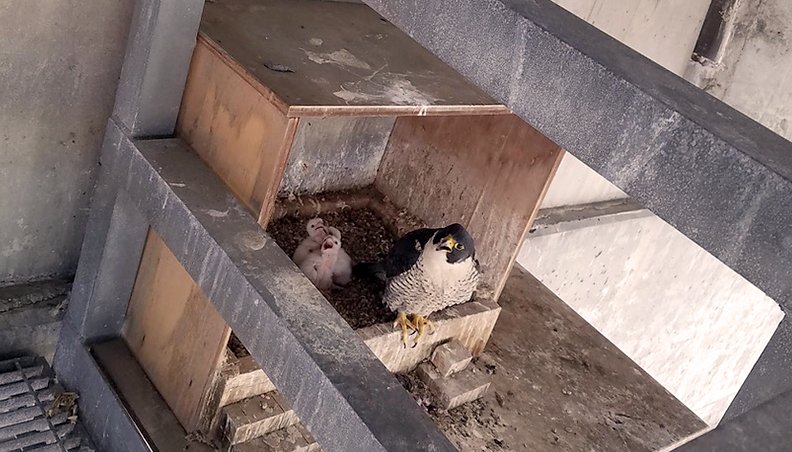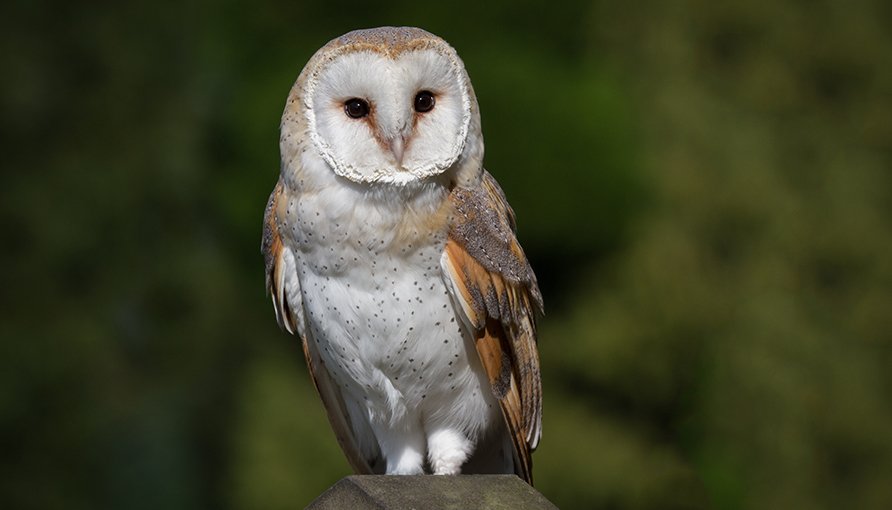2020 Spring News

Three peregrine eyasses and their mother at the West Seattle Bridge nest, May 2020 (BDI Inc., courtesy of Seattle Department of Transportation).
May 18, 2020
Dear Friends of URC,
Good news: Raptors are oblivious to Covid-19. And while we watch them, so, temporarily, are we.
2019, our second year as a nonprofit, kept us busy. No sophomore slump for us! Read our 2019 Annual Report
2020 began with huge smiles as donors put us on the home stretch to complete our Rodenticides in Raptors study. And at the halfway point of our field season, our local raptors give us much to smile about, too.
Rodenticides in Raptors
Rat poison (rodenticide) is widely used in areas where wildlife hunt. Many raptors consume poisoned rodents and retain the poison for a long time. The most common rat poisons are anticoagulants. Anticoagulants slow or prevent blood clotting, causing a poisoned animal to bleed heavily or fatally, even from minor injuries. Sublethal effects, which lower an animal’s fitness, are also likely: lower bone density (higher risk of breakage), more cardiac stress, poorer organ function, lower fitness and body condition, and higher disease susceptibility.
This problem has been well documented in other regions and long suspected but never tested for in Washington State. Urban Raptor Conservancy is conducting the first such study in Washington.
Our study depends on lots of help. Staff at PAWS Wildlife Center donate their time and skills to collect liver tissue from dead or dying raptors received at their clinic. We send the samples to a toxicology lab for analysis. Each sample costs about $80. We will test 120 raptors.
Now the bad news. Our local raptors are consuming a lot of rat poison. So far we have results from 60 raptors: 16 Cooper’s hawks, 8 red-tailed hawks, and five owl species (20 barred owls, 8 great horned owls, 5 barn owls, 2 Northern saw-whet owls, 1 Western screech-owl). Overall, 82% (49 birds) were positive for at least one anticoagulant rodenticide, 73% had two different rodenticides, and 55% had three or four different rodenticides. The percentages are even higher for owls alone, because they eat rodents almost exclusively.
These numbers represent individuals.
- A young Cooper’s hawk fell from its nest at Salmon Bay Park in Ballard, still downy, and later died. Although barely three weeks old, this bird had three different rodenticides. Where in Ballard did they come from?
- Two barn owls were rescued from Key Arena in downtown Seattle and taken to PAWS, both showing toxicosis from anticoagulant rat poison. One died. It had far higher levels of rat poison than any other raptor we’ve tested.
We are now halfway through the study, with more samples ready for testing as soon as we can find our way through the pandemic.
2020 Field Season
Since early March, we have been identifying nesting pairs of Cooper’s hawks, peregrine falcons, and merlins in Seattle and the Puget Sound region. Incubation is under way. We will monitor nesting and fledging success throughout the summer.
Cooper’s Hawks
- Thanks to many dawn patrols by dedicated volunteers, we have identified 57 Cooper’s hawk nests in Seattle. Wow!
- Since 2003, the Seattle Cooper’s Hawk Project has put color-ID leg bands on 577 Cooper’s hawks. A remarkable 41% of them (243) have been seen again. Many of these bands were photographed or reported by observers like you. Thanks to everyone who contacts us with these reports.
Report a Sighting
Peregrine Falcons
- For only the second time since 1994, no peregrines nested at the flagship site at 1201 Third Avenue.
- Three eyasses have hatched at the West Seattle Bridge. As is now widely known, the high-rise West Seattle Bridge closed abruptly in March 2020 because of damage. The bridge will remain closed through at least 2021. After this season, the future of this nest site is uncertain.
A new falcon cam was installed at the downtown nest at Heritage Bank, and just in time: four young hatched on May 1-2! We will put color-ID bands on the eyasses on May 24.
Merlins
The Seattle Merlin Project has identified over a dozen nests. Some new sites came from watchers who were especially observant thanks to the quarantine. It’s exciting that several banded adults are parenting this season’s nests, including some that have been followed for five or more years.
Merlin pairs will spend most of May quietly incubating eggs. Hatching typically occurs in early June, with young taking their first flights in early July. Contact us if you observe merlin activity during the breeding season (March through July).
Report a Sighting
Beyond Year Three
URC is developing a strategic plan to further our missions of research, conservation, and education in support of urban raptors in our region. Our efforts are aided by the valuable and wide-ranging contributions of Jeremiah Holt and Robyn Ricks, our new Advisory Board.
Gratitude
As a new nonprofit, we long struggled to gain our footing and raise funds to launch our Rodenticide in Raptors study. And we did! Almost 100 donors made our initial analyses possible. Then we received critical support from several sources — the dedicated California nonprofit Raptors Are The Solution (RATS), Seattle Audubon Society, friends of Connie Sidles, and Patagonia — enough to complete the entire study, from testing to publication. We are buoyed and honored by your shared faith in our mission.
We much prefer our excitement in the field to the administrative challenge of keeping Urban Raptor Conservancy running! We depend upon an amazing army of citizen scientists and financial support from people like you. It’s a tough time to ask for contributions, but as you can, your donations sustain us, and we are grateful. Our sincere thanks to you all.

Barn owl (Alan Tunnicliffe, Shutterstock).